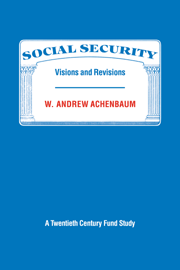Book contents
- Frontmatter
- Contents
- Dedication
- Foreword
- Acknowledgments
- Introduction
- Part I Social security comes of age
- Part II Current social security issues in historical perspective
- 5 Retirement under social security
- 6 Social security and the modern American woman
- 7 Universal coverage: an either/or proposition?
- 8 Federal health care programs and social security
- 9 A vision renewed: individual needs and mutual responsibility
- Notes
- Index
7 - Universal coverage: an either/or proposition?
Published online by Cambridge University Press: 04 August 2010
- Frontmatter
- Contents
- Dedication
- Foreword
- Acknowledgments
- Introduction
- Part I Social security comes of age
- Part II Current social security issues in historical perspective
- 5 Retirement under social security
- 6 Social security and the modern American woman
- 7 Universal coverage: an either/or proposition?
- 8 Federal health care programs and social security
- 9 A vision renewed: individual needs and mutual responsibility
- Notes
- Index
Summary
Although members of the NCSSR were deeply divided over the need to change the retirement-age baseline from sixty-five and were unwilling to make major changes in the treatment of women, most agreed that coverage under social security should be broadened as much as possible. The commissioners called for extending mandatory coverage to all newly hired civilian employees of the federal government as well as to all employees of nonprofit organizations. They also wanted to prohibit withdrawal of state and local governments from social security coverage. It was the need to generate additional revenues, not any fresh new perspective on universal coverage, that led Congress to accept these recommendations with only minor alterations. Implementing them, according to the NCSSR Final Report, would save the system at least $23.2 billion by 1989 and would eliminate about 17 percent of the long-range payroll deficit.
At first glance, the requirement that new federal workers and employees of nonprofit institutions contribute to social security appears to be yet another instance of making marginal adjustments in order to generate more income for the OASDHI program. Actually, addressing the question of universal coverage under social security threatened to destroy the fragile legislative consensus in favor of the NCSSR proposals. Several last-ditch efforts to postpone extending coverage to federal employees were made in the Senate, but many lawmakers feared that any such delay would jeopardize the entire bailout plan.
- Type
- Chapter
- Information
- Social SecurityVisions and Revisions: A Twentieth Century Fund Study, pp. 142 - 160Publisher: Cambridge University PressPrint publication year: 1986



